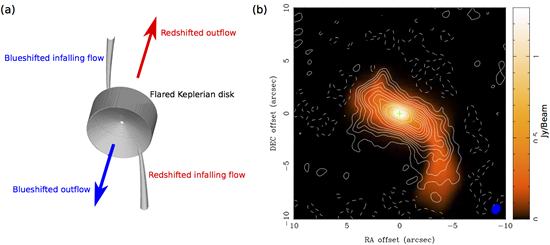Infalling Flow toward a Keplerian Disk around the Protostar L1489 IRS

(a) Schematic figure of our kinematic model. Red and blue arrows denote the directions of the outflow from the protostar. This protostar is surrounded by a Keplerian disk, and there two streams of infalling flow connecting the disk. The infalling flows transfer mass and angular momentum to the disk, allowing it to grow. (b) Image of the observed gas distribution around the protostar (contour) overlaid on the model distribution generated using our kinematic model (color). A cross shows the location of the protostar.
Circumstellar disks are ubiquitous around young stellar objects and are considered to be the sites of planet formation. Understanding the formation mechanism of circumstellar disks is one of the key issues in present astrophysics because it is the starting point to form planetary systems. We have conducted ALMA observations toward one of protostars likely having forming disks to investigate detailed kinematics of its ambient gas. Our observational results show that most of the ambient gas is following Keplerian rotation around the protostar, suggesting a circumstellar disk is indeed formed. Moreover, we further find that the motional velocity of the outer ambient gas is deviated from the Keplerian rotation. Our analyses of its structures and velocity features show that the outer gas is free falling toward the disk. Such the gas motion can transfer mass and angular moment to the disk from its envelope materiel, allowing the disk to grow. Our ALMA observations capture this on-going disk formation. (Yen et al. 2014, ApJ, 793, 1)